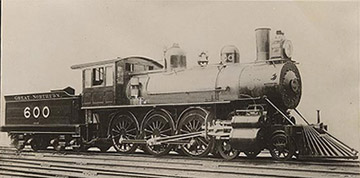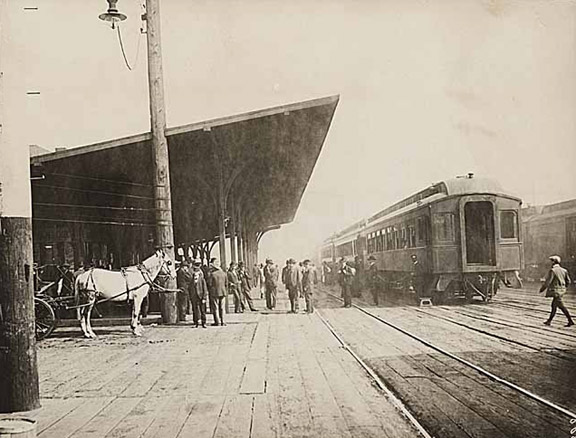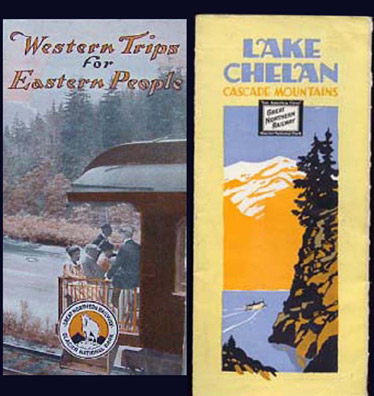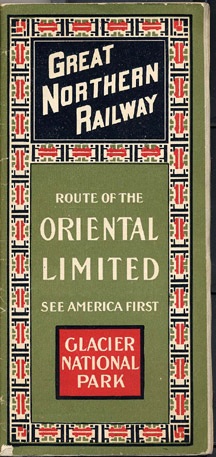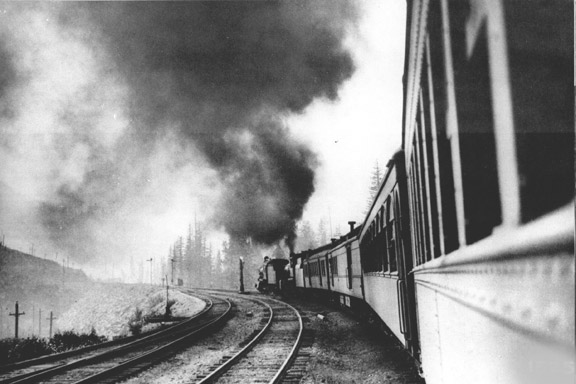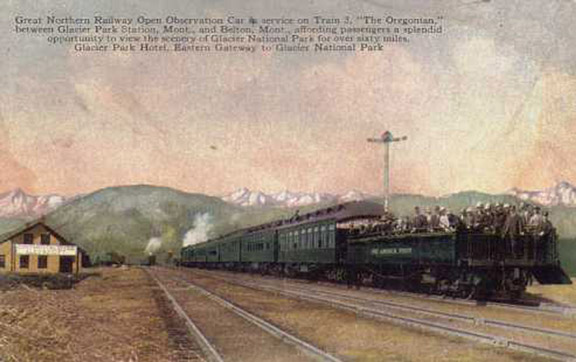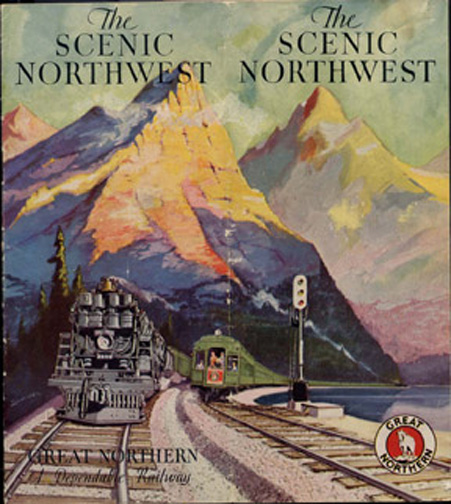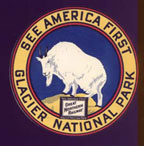home gnus boomer boneyard links trackplan recent layout pix

| Puget Sound Ltd | Fast Mail | Oregonian | Glacier Park Ltd |
| Part 1 - GNRHS Reference Sheet #303 dated June 2002 Part 2 - #305 dated Dec 2002 | |||
The Companion Trains Three and Four
In starting its transcontinental Service, Great Northern faced stiff competition from the Canadian Pacific, Union Pacific and especially the Northern Pacific. To build traffic, Great Northern began an ambitious immigration program to populate its route. The immigration program pursued by Great Northern was a success. By 1903, traffic and business warranted a second transcontinental train. The Great Northern Flyer was renumbered from 3 and 4 to 1 and 2 in 1903. The Puget Sound Express westbound and Eastern Express was added, assuming numbers 3 and 4. Besides providing 'Double Daily Service' as GN's ads claimed, the arrangement now provided reasonable service to those on line communities through which the Flyer pass at some ungodly hour.
GN changed the train's name three times in twelve years. In 1906, 3&4 became The Fast Mail; in 1910 they became The Oregonian; and finally in 1915 the name The Glacier Park Limited appeared, promoting its on line tourist attraction. Three and four would carry that name for 14 years.
The Puget Sound Express and Eastern Express
On the east end, the Puget Sound /Eastern Express extended transcontinental service to Breckenridge, and Willmar. North of Fargo, the train followed the new line, built in 1903, between Casselton, Mayville and joined the mainline at Larimore. The Flyer continued to operate via St Cloud, Grand Forks, and Devil s lake. Advertisements, announcing the train, stated that the trains had all new equipment.
E-7 Ten wheelers such as #600 handled the Expresses on the more level districts
| Westbound | Eastbound | |||
| Train #3 | Train #4 | |||
| (Sun) | Lv 5:00 PM | St Paul | Ar: 2:45 PM | (Wed) |
| (Wed) | Ar 9:00 AM | Seattle | Lv: 7:30 PM | (Sun) |
| 66:30 Hrs | Running Time | 66:15 Hrs |
| Dates of Operation: | March 3, 1903 - May 1906 |
| Route: | St Paul to Seattle via Willmar, Casselton, Mayville, Larimore, Minot, Havre, Whitefish, Spokane, Cascade Tunnel , Seattle |
| Mileage: | 1818 |
| Consist: | St-Paul - Seattle. |
| Baggage-mail-express car, day coaches, family tourists cars, smoker, dining cars, palace sleeper | |
| Schedule: | Official Guide March 1903 |
The Puget Sound Express or the Great Northern Flyer has just arrived at Seattle's Railroad Ave depot in this undated pre-1906 photo |
The new Puget Sound /Eastern Express ran as the companion train to the Great Northern Flyer, providing service to the principal cities half a day apart. In 1904, the Great Northern Flyer carried numbers 1&4 and the Express carried numbers 2&3. The Expresses offered evening departures from St. Paul and Seattle. Numbers 3&4 connected with trains 153/154 at Havre for the Butte connections.
A train, possibly
the Eastern Express in the Cascades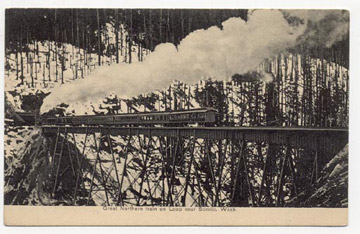
Great Northern, however, continued to have problems crossing the Cascades. In 1903 more than 100 of number four's passengers were almost asphyxiated when a coupler broke, stalling the train in the tunnel.
Fast Mail
| Dates of Operation: | May, 1906 - July 3, 1910 |
| Route: | St Paul to Seattle via Willmar, Casselton, Atena, Devils Lake, Minot, Havre, Whitefish, Spokane, Cascade Tunnel , Seattle |
| Mileage: | 1814 |
| Consist: | St-Paul - Seattle. |
| Baggage-mail-express car,
day coaches, family tourists cars, smoker, dining cars, palace sleeper |
|
| Schedule: | Official Guide June 1906 |
| Westbound | Eastbound | |||
| Train #3 | Train #4 | |||
| (Sun) | Lv 3:00 PM | St Paul | Ar:10:40 AM | (Wed) |
| (Wed) | Ar 7:00 AM | Seattle | Lv: 8:00 AM | (Sun) |
| 66 Hrs | Running Time | 72:40Hrs |
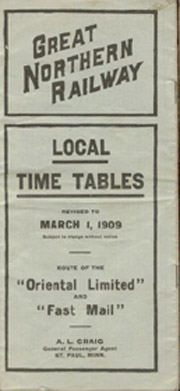
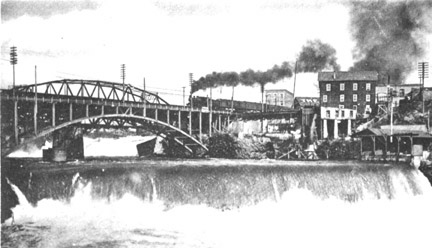
In May 1906,
the Puget Sound and Eastern Expresses became the Fast Mail. Apparently
Great Northern s advertising people felt that the Express name was
unimaginative and too pedestrian. The Fast Mail was a popular song
in the 1890s and the Fast Mail train concept had captivated the public
s attention. The Fast Mail, like the Expresses, was a complete first
class train carrying coaches, sleepers, smoking and dining cars. Unlike
A westbound GN passenger train crosses Spokane Falls
In 1907, GN built a new line from Casselton via Atena to Devils Lake
where it rejoined the mainline. The Fast Mail operated via Willmar,
Breckenridge and the new Casselton-Devils Lake line. The Oriental
Limited traveled via St Cloud and Grand Forks to Devils Lake. West
of Devils Lake, an identical route was taken to the Pacific coast.
Atlantics and Pacifics were ordered for the Fast Mail and the Oriental
Limited. The 35 H-2 Pacifics sporting 69" drivers and a 33,090
lbs tractive effort, were the most powerful passenger locomotives
to date. Fifty class J-1 prairies, acquired for dual service, also
powered the Fast Mail. Both the J-1 and H-2 classes had a couple of
locomotives fitted with a superheater as an experiment. Both shared
the same tractive effort and many of the same details.
 Problems in the Cascades continued. In December 1907, Pacific 1438
pulled train #4 out of Skykomish and was caught in the tunnel by two
avalanches, one ahead and one behind. On February 22, 1910, local
train #25 and mail train #27, neither of which carried a diner, were
stuck by a blizzard at Wellington. The storm intensified stranding
the trains for eight days. On March 1, 1910 they were destroyed by
avalanches, with a loss of 98 lives. Great Northern was extremely
sensitive to the unfavorable publicity generated by this disaster.
Shortly after the accident, the town of Wellington was renamed Tye
and subsequent Great Northern advertising noted that Great Northern
no longer routed its trains through Wellington, having relocated its
line through the town of Tye.
Problems in the Cascades continued. In December 1907, Pacific 1438
pulled train #4 out of Skykomish and was caught in the tunnel by two
avalanches, one ahead and one behind. On February 22, 1910, local
train #25 and mail train #27, neither of which carried a diner, were
stuck by a blizzard at Wellington. The storm intensified stranding
the trains for eight days. On March 1, 1910 they were destroyed by
avalanches, with a loss of 98 lives. Great Northern was extremely
sensitive to the unfavorable publicity generated by this disaster.
Shortly after the accident, the town of Wellington was renamed Tye
and subsequent Great Northern advertising noted that Great Northern
no longer routed its trains through Wellington, having relocated its
line through the town of Tye.
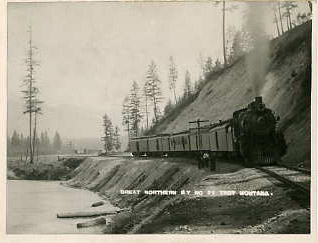
Number 27 is pictured near Troy shortly after its start.
The Fast Mail, numbers 3 and 4 should not be confused with mail trains 27 and 28 that began in 1909.
By July, the name Fast Mail was withdrawn, in part because of the unfavorable publicity generated by the Wellington wreck and did not appear in public time tables until the 1930s. For clarification, trains number 27 & 28 commenced operation on October 4, 1909, and were known as mail trains on the Great Northern, carrying no passengers. In 1910, when the Fast Mail was renamed the Oregonian, GN employees began calling No 27 & 28 the Fast Mail. Although it was mail train number 27, not the Fast Mail, number three, which was involved in the wreck, the public made no distinction.
Oregonian
Numbers: 3 & 4
Dates of Operation: July 3, 1910 April 25, 1915
Number 3&4's name was changed from the Fast Mail to the Oregonian on July 3, 1910. The Oregonian provided direct service to Portland with sleeping cars cut out at Spokane for Seattle and carried on GN locals #25 & #26. The operation was opposite to the Oriental, whose Portland sleepers were cut out for transfer to the SP&S. The through St Paul-Portland service lasted for a year until mid-1911 when the Oregonian was re-routed to Seattle. Portland cars were then switched at Spokane. As noted above, another factor in renaming the train was probably the Wellington Disaster in March, 1910.
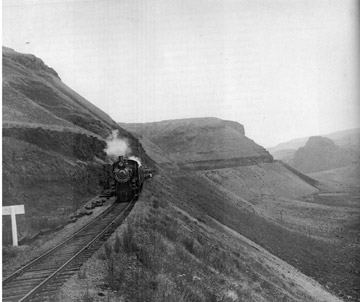
The Oregonian in Eastern Washington's Devil's Canyon between Spokane and the Columbia River
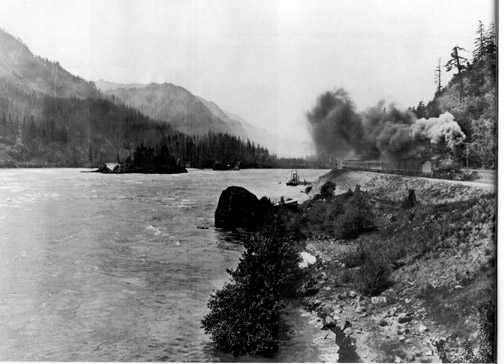 The Oregonian along the Columbia River
The Oregonian along the Columbia River
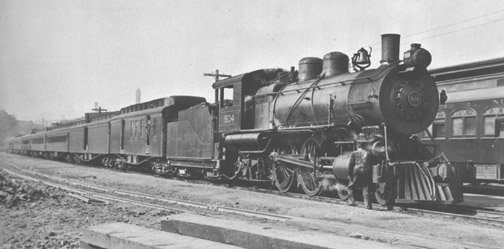
Thus the GN Portland connection shifted from the UP station, north of its Havermale Island depot, to the NP station which was south of Havermale Island. The long awaited SP&S/GN connection became a reality in June 1910 when the tunnel under the Greenwood Cemetery near Ft. Wright was finished. The first SP&S train from GN Depot operated on June 5, 1910.
The Oregonian ready to leave the SP&S station in Portland
St Paul to Portland Dates of Operation:July 3, 1910 - April, 1912 |
|
Route: Willmar, Casselton, Atena, Devils Lake, Minot, Havre, Whitefish, Spokane, Portland |
|
| Mileage:1855 | |
Consist: Baggage-mail-express car, day coaches, family tourists cars, smoker, dining cars, palace sleeper |
St-Paul - Portland Via SP&S Spokane-Portland |
| Reclining chair cars, & Palace Sleepers | St-Paul - Seattle |
| Observation car (summer only) | St-Paul - Portland |
| Open Air observation car | Along Glacier National Park |
| Official Guide August 1910 | |
| Westbound | Eastbound | |||
| Train #3 | Train #4 | |||
| (Sun) | Lv 10:45 PM | St Paul | Ar:7:05 AM | (Wed) |
| (Wed) | Ar 8:45 AM | Portland | Lv: 11:00 AM | (Sun) |
| 60 Hrs | Running Time | 66:05Hrs |
Picture of the new Spokane depot believed to have been taken the day it opened in 1902.
St Paul to Seattle
Dates of Operation: April 1912 - April 25, 1915
Route:
St Paul to Seattle via Willmar, Fargo, New Rockford, Minot, Havre, Whitefish, Spokane, Cascade Tunnel , Seattle
Mileage:1786 Consist:Baggage-mail-express car, day coaches, family tourists cars, smoker, dining cars, palace sleeper St-Paul - Seattle. Observation car (summer only) Spokane - Seattle. Reclining chair cars, & Palace Sleepers Spokane- Portland Open Air observation car Along Glacier National Park Official Guide June 1912
Westbound Eastbound Train #3 Train #4 (Sun) Lv 10:45 PM St Paul Ar:10:40 AM (Wed) (Wed) Ar 7:00 AM Seattle Lv: 8:00 AM (Sun) Hrs Running Time 60:40Hrs
In 1912, the shorter Surrey cutoff was completed and the Oregonian and Oriental both used this line through New Rockford. The Oriental traveled through Grand Forks westbound and New Rockford east bound. The Oregonian went through Grand Forks eastbound and New Rockford westbound. The Willmar line was longer than the St. Cloud one and was combined with the Surrey Cutoff. Because of their respective schedules, the Oregonian carried more sleepers westbound and the Oriental carried more eastbound.The Oregonian offered an observation only between Seattle and Spokane.
Cards were provided free in the observation

After the Oregonian s name was changed to the Glacier Park Limited, the pattern of alternating routes through North Dakota and Minnesota continued, lasting until 1931 when numbers 3 & 4 ceased to operate as a transcontinental train.
Through connections to San Francisco via the Great Northern Pacific Steamships, were provided by the Oregonian and SP&S.
Great Northern's pavillion at the San Francisco's Pan-Pacific Exibition in 1914
See America First
Glacier Park Limited
Numbers: 3 & 4
Dates of Operation: April 25, 1915 - May 31, 1929
Dates of Operation: April 25, 1915 - May 31, 1929 Route:
St Paul to Seattle via Willmar, Fargo, New Rockford, Minot, Havre, Whitefish, Spokane, Cascade Tunnel , Seattle Mileage:1786 Route: Seattle to St Paul via Spokane, Whitefish, Havre, Minot, Devils Lake, Grand Forks, St Cloud Mileage:1814 Consist:
Baggage-mail-express car, coach, smoker, dining cars, Standard and Tourist sleepers
St-Paul - Seattle Standard sleepers Spokane - Portland Observation car (summer only) Spokane - Seattle Open air observation car Along Glacier National Park; Seattle-Skykomish Official Guide April 1915
Westbound Eastbound Train #3 Train #4 (Sun) Lv 10:45 PM St Paul Ar:10:45 PM (Tues) (Wed) Ar 8:45 AM Seattle Lv: 9:15 AM (Sun) 60 Hrs Running Time 59:30Hrs
The Glacier Park Limited was inaugurated on April 25, 1915 to promote its online scenic attraction as a tourist destination. Since the Park s opening in 1910, Great Northern's advertising stressed the Glacier National Park's unequaled scenery and easy access by its trains. The railway realized that its transpacific freight routes were secure and far more revenue would be generated by travel to Glacier Park than to the Orient.
To attract tourist business, compartment observation cars were carried between Seattle and Spokane in the summer months. Open observation cars were added for the runs through the Cascades and around the south edge of Glacier Park. The number of sleeping cars varied with the season and direction of travel. Its scheduled times through the major cities meant that more sleepers were carried eastbound. Since both the Oriental Limited and Glacier Park Limited carried identical gold leaf lettering reading Great Northern , the equipment was interchangeable.1915 Timetable cover
The doubleheaded Glacier Park Limited catches a red block in the Cascades
A happy group of tourists are about to board the Glacier Park Limited .
The growing Northwest area was generating express traffic for eastern markets. Express reefers often carried fruit, produce and Alaskan salmon eastbound from the Northwest.
USRA Era
Between May 26, 1918 and May 30, 1920, when the Great Northern was governed by the United States Railway Administration, the Glacier Park Limited disappeared from the timetables. Trains 3 & 4 did operate between St Paul and Havre, but with a scaled back consist. Compartment observations and tourist sleepers were eliminated.
Westbound, coaches and a first class sleeper were carried from St Paul to Havre, where they were transferred to train 235 for the run to Butte. A dining car was carried from St Paul to Wolf Point, Mont. Another sleeper was carried from St Paul to Willmar whence it was forwarded to Yankton, SD on train 51. One more sleeper was picked up at Williston for Great Falls.
Eastbound, number 4 picked up coaches and sleepers from Butte on train 236 before starting from Havre. At Wolf Point, a diner was added and carried to Minot. From Minot, the diner, sleepers and coaches were forwarded on train 30, the Red River. Train 4 continued the following morning as a local to St Paul.
Post USRA
1928 Timetable and Call of the Mountains booklet
With the end of government operation in mid-1920, the Glacier Park Limited reappeared on the St Paul- Seattle run. Tourist sleepers and compartment observation cars were returned to the consist. As before the war, the observations were carried between Seattle and St Paul in the summer months and between Seattle and Spokane year round. Through connections to Portland were again offered for the first time since 1911.
Consist
Motive Power
By 1920 the shortcomings of the P-1s had long since been recognized and had been withdrawn form passenger service. A roster of 45 E-14 ten-wheelers and 45 H-4 Pacifics was more than adequate to protect mainline passenger trains. In 1922, the division points for changing locomotives had changed. Westbound fresh locomotives were added at Breckenridge, Minot, Williston, Wolf Point, Havre, Cut Bank, Whitefish, Troy, Spokane, and Wenatchee. Electrics pulled steam power through the old cascade tunnel. Eastbound, changes were made at Devils Lake and Barnesville instead of Breckenridge.
Immediately after regaining control from the USRA, GN began a program of rebuilding its passenger locomotive roster. Between 1921 and 1927, fifteen dual service class J Prairies became class H-6 Pacifics with an increased TE of 40,820 pounds. The E-14 class became class H-5 and H-7 Pacifics, retaining their 38,580 pounds TE. In the fall of 1923, twenty-five class P-2 Mountains arrived. With 54,840 pounds TE, the P-2 class, had more than enough muscle to permit the schedule to be cut to 70 hours.
By 1928, Y-1 & Z-1 electrics were being coupled on ahead of steam locomotives for the run between Skykomish and Wenatchee and through the old Cascade Tunnel.
Passenger Equipment
In 1921, older equipment, a mixed consist of steel and wooden head end cars, coaches, sleepers and dining cars were used on Glacier Park Limited. The normal consist was a RPO/baggage, baggage and express car, first and second class coaches, tourist sleeper, diner, first class sleeper. As before the USRA era, a compartment observation car was assigned between Seattle and Spokane. In the summer, it ran between St Paul and Seattle and the open air observation returned to its run around the southern edge of Glacier Park. To attract tourist business, plans were made to refurbish the mainline trains which had been well worn during the USRA era.Pullman operation of all sleeping cars on the Glacier Park Limited was instituted in 1922. It proved so successful that an agreement was signed by which Pullman also furnished sleepers for the Glacier Park Limited. Unlike the Oriental Limited, Pullman did not build new equipment for the Glacier Park Limited, servicing with its line cars instead. GN applied steel sheathing to its assigned equipment between 1922 and 1924.
Four new open observation cars were built providing service through the Cascades and around the southern edge of Glacier Park.
Train three open observation at Marias Summit in 1913
One car went east from Seattle and ran along Puget Sound for thirty miles before turning east and into the Cascades as far as Skykomish. It returned to Seattle that evening.
Eastbound Depart Seattle at 8:00 am Train #4 Arr Skykomish 11:30 aM Westbound Depart Skykomish on at 4:00 PM Train #1 Arr: Seattle 7:00 PM The other three were assigned to Glacier Park, traveling on a three day circuit:
Day One: Depart Glacier Park at 8:05 am Train #3, Arr Troy 3:30 PM Day Two: Depart Troy on at 1:35 PM Train #2 Arr: Whitefish 5:35 PM Day Three: Depart Whitefish at 7:00 am Train #4 Arr Glacier Park Station 10:20 AM The eastbound Glacier Park Limited offered stunning views of Puget Sound, the Cascades and Rockies. The westbound Glacier Park Limited had a seven hour run through the Rockies and beautiful Kootenai Canyon. The Glacier Park Limited carried the open air observations for only four years, from 1925 until 1928.
The 1929 edition of GN's The Scenic Northwest featured the new S-1 Locomotives and the Empire Builder's solarium observation.
Note the roofs on the Empire Builder's are Pullman green not black.
In 1929, the Cascade Tunnel was opened and in June a new train, the Empire Builder was launched on an even faster schedule. The modern Oriental Limited with its 1924 built equipment, assumed numbers three and four, replacing the Glacier Park Limited. The speedier Empire Builder, with its enclosed Solarium Observation spelled the end of both the grand open air observations and the Glacier Park Limited on the Great Northern.
“See America First”
